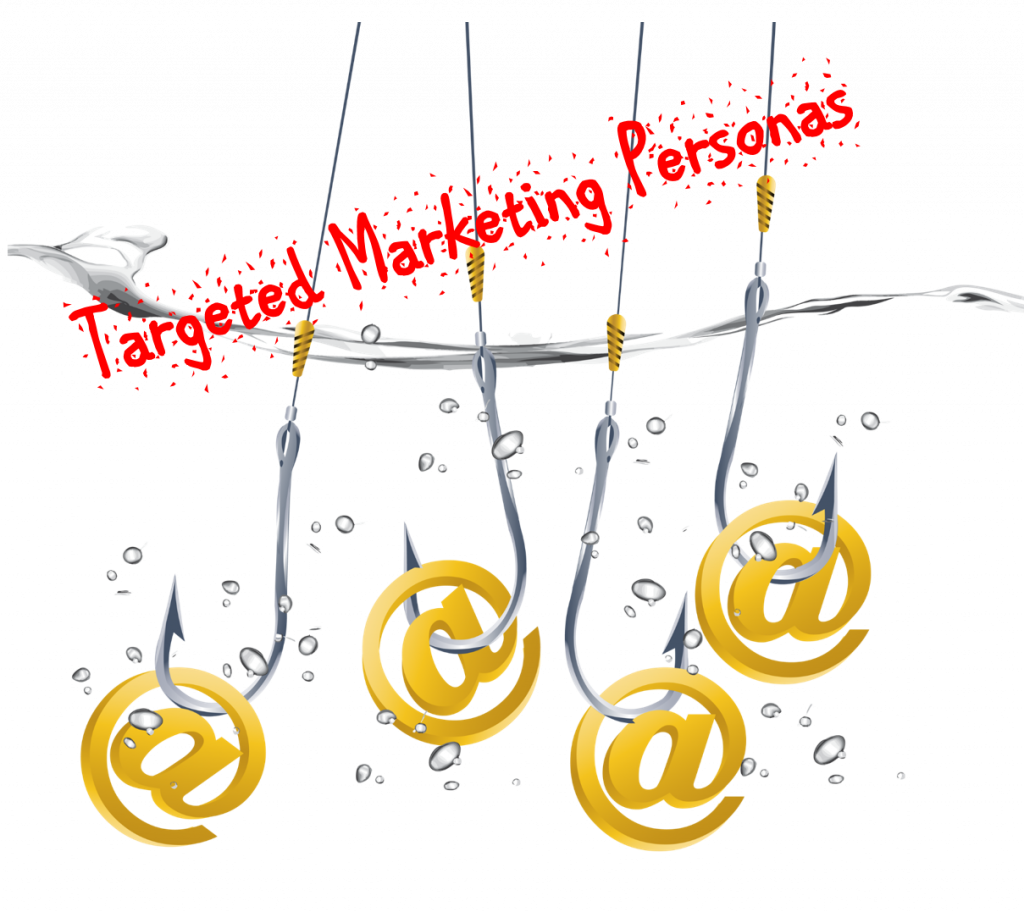Have you ever gone fishing? If you have, then you understand your chances of catching something improve when you know a little bit about the fish you’re after and the environment in which it lives. Charles E. Gaudet II (@charlesgaudet) likens targeted marketing to fishing. “[1] He explains:
“If you wanted to catch a fish, what would be the best way to go about it? Well, you could choose a spot at random, fit your line with whatever was on special at the bait and tackle store, and simply hope for the best. Is it possible to catch fish this way? Of course. Put your line in the ocean long enough, and you’ll probably get lucky. But it’s certainly not the best strategy. A more effective approach would be to determine which fish you wanted to catch. Are you deep sea fishing for marlin or fly-fishing for trout? It’s going to make quite a difference where you choose to fish. And what you’re after will determine the rest of your approach. If you really want to bring home a good catch, consider when the fish will be breeding. You’ll need the right bait, the right rig, even the right time of day. You have to do your research. The same principles that make a good fisherman also apply to marketing.”
There is one big difference between fishing and marketing. Fish don’t know you are trying to catch them but customers do. Unless you offer the right incentives to the right people, they won’t take the bait. But who are the right people and what is the right bait? As Gaudet suggests, you have to do your research. Will Humphries (@JustCallMeWill), Head of Digital Marketing at Internal Results, explains, “Historically, marketers have defined target markets with a general description. … While this approach is still common, creating buyer personas has become a popular and often more effective approach to lead generation. A buyer persona is a semi-fictional representation of the typical customer within a target market.”[2] Marketers have always known that segmenting customers was wise. For example, men don’t generally buy products intended for women and vice versa. But today marketers can refine their targeted audiences (i.e., their customer personas) with much more granularity thanks to big data and advanced analytics capabilities found in cognitive computing systems. Knowing who constitutes your best customers is important. As Leslie Ayers (@layerssf) writes, “You wouldn’t be in business without a clear understanding of your target audience.”[3] However, creating targeted marketing personas may not be as easy as you think.
One big mistake business executives make is assuming they intuitively know who their best customers are. As Anna Kayfitz (@aniagl), a consultant for StrategicDB, notes, “Although segmenting on the basis of customer profiles or personas constructed on assumptions is a good starting point, especially when you are just starting out, it is unwise to finalize your segmentation without first doing analysis. For example, defining as profitable a segment that actually brings in the least amount of revenue is a mistake that only looking at actual numbers can show you is a mistake. Therefore, customer data must be analyzed when creating your segments.”[4] Another mistake business executives can make is not understanding the data they are using. Anders Ekman (@andersekman), President of DataMentors, explains, “As manufacturers seek better ways to target their customers, many are finding that their marketing databases are less than accurate, with incomplete and inaccurate data that severely impacts their ability to clearly define and understand end-users and sales channels. Meanwhile, these manufacturers generally deal with huge quantities of information from multiple, disparate sources. Many of these sources are often stored in legacy systems, further limiting the ability to integrate and analyze for comprehensive customer intelligence. Too many manufacturers have gotten stuck at this point, or limped along, trying to make the best of their data mess.”[5] Cognitive computing systems can also help with the data challenge because they can integrate structured and unstructured data before it is analyzed. Humphries discusses specific benefits that can be derived from creating data-based targeted marketing personas. They include:
- Humanizing the target market. “The goal is to precisely target individuals with relevant messages, even in the midst of targeting a large segment. A buyer persona fits better with precise targeting objectives than a general audience description because it humanizes your customer base.”
- Refining lead generation. “A more precise perspective of your market allows for more refined lead generation. … Highly targeted prospects lead to better conversation rates, reduced sales cycle times, better customer retention and improved financial performance.”
- Better positioning. “You not only attract the best possible prospects through your lead generation activities, but buyer personas enable stronger product positioning. Since you have a detailed definition of the prototypical customer for a solution, it is easier to consider his needs and deep pain points. When you have a clear understanding of the problem a prospect faces, it is simpler to sell on the benefits that matter.”
- Process consistency. “With buyer personas, you also mitigate the potential for haphazard selling processes. Each marketing and sales rep has the same profile of the target customer. Consistent lead generation processes lead to efficient results and the most effective presentation of your solutions to the marketplace.”
Andy Narayanan, Vice President of Visual Intelligence at Sentient Technologies, states, “A consumer journey tailored to a buyer’s individual wants and preferences is a smart goal.”[6] He observes, however, that previous methods of trying to personalize targeted marketing campaigns have serious shortcomings. “Since current personalization techniques revolve around demographics and past buying and browsing patterns,” he writes, “they don’t actually offer true personalization. Rather, they use the historical behavior of buyers to suggest products, both onsite and in the form of retargeted ads.”[6] He continues:
“This allows for a more personal experience, but not a true personal experience. To put it another way, it only buckets consumers into similar groups. And while that approach has its benefits, it misses the mark in important ways. For one, recommendation algorithms don’t serve new buyers without a purchase or browsing history very well. They also don’t surface a large percentage of an e-tailer’s catalog; by only showing products other users have purchased, these algorithms effectively ignore more appropriate products that may be exactly what the current buyer is looking for. Likewise, current personalization approaches don’t account for unspoken and subtle preferences individual buyers have. Rather, they account for categories in a spreadsheet. Many of these issues are born from the fact that, today, e-commerce sites (and e-commerce search) are designed around databases, not people. And while search and personalization have evolved in the past decade, they haven’t evolved far enough. Recommendation algorithms can provide more personalized choices to shoppers, but they fundamentally do not treat buyers as individuals: they compare shoppers to each other. Artificial intelligence (AI) solves for all these problems. It understands buyer intent in the moment, just like an in-store sales associate would, by interacting with the customers as they shop to more fully understand what they’re really looking for. An AI-assisted shopping experience is more personal because it doesn’t rely on similar (but different) users to recommend the right product. It looks at the individual shopper, in the moment, and helps them find the right item.”
To use another sports analogy, personas can help put customers in the ball park but they don’t usher them to a specific seat. Cognitive computing can bring them much closer to finding the seat they want. Narayanan concludes, “By using AI, it’s possible to not only improve the actual experience of shopping on an e-commerce site, but help your buyers get what they really want. And at the end of the day, a delighted customer should be the goal anyway.” In other words, jumping back to the original analogy, the right bait brings in the right fish.
Footnotes
[1] Charles E. Gaudet II, “How To Develop Your Buyer Persona And Reel In Better Customers,” Forbes, 28 October 2014.
[2] Will Humphries, “What’s the Big Deal with Buyer Personas?” Business 2 Community, 19 August 2016.
[3] Leslie Ayers, “Why and How to Use Persona Marketing,” Intuit Small Business Blog, 6 November 2013.
[4] Anna Kayfitz, “Seven Segmentation Mistakes That Will Cost Your Business Money,” MarketingProfs, 2 August 2016.
[5] Anders Ekman, “Understand Your Best Customers To Find New Revenue Opportunities,” Manufacturing Business Technology, 12 August 2014.
[6] Andy Narayanan, “Getting Personal with Artificial Intelligence,” Chain Store Age, 22 April 2016.





